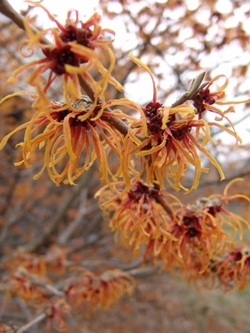 Jelena
Jelena - Spend time sketching ideas on graph paper and making notes on what is lacking in your garden. Often the best garden plans are hatched in the middle of winter when you stare out of the window at a blank white landscape and long for the colors and fragrances of summer.
- The time to start planting your first row of peas outside should be only a few weeks away -- traditionally weather permitting this is done on St. Patrick’s Day. This year I think it could be weeks later. Before you start sowing, sketch out your summer vegetable and cutting garden on paper, keeping in mind plot rotations and compass directions so tall plants don’t shadow sun loving crops.. There is still enough time to sow slow-growing annuals from seed. Plant in a 2/3 soil-less planting medium, 1/3 perlite mixture and use heat seedling mat to maintain an even temperature of 75 degrees F. day and night.
- Despite frigid temperatures the days are still getting longer and brighter which encourages houseplant growth. Start fertilizing your plants either by adding one-quarter the recommended strength every time you water, or full strength every couple of weeks until April when you can increase your fertilization program further in preparation for summer.
- If the recent snows and freezing weather has damaged odd evergreen branches (or as with my sarcococca whole sections) it’s a good time to prune out the damage. Some of my evergreens look really sickly, those I’m leaving until late April in the probably vain hope they perk up or some new growth appears.
- It kills me to do it, but I now do throw out my paperwhite bulbs when they finish blooming. They’re not hardy in zone 6 and I’ve tried coddling them, leaving the foliage to die and saving them for the next year with disappointing results --there’s nothing worse than forcing a bunch of bloom-free leaves. I now shut my eyes and throw them on the compost heap.
- When there’s a warm break in the weather, and if the snow allows, check your perennials. If the frost has heaved any up, wait for a thaw and gently dig them into the soil to ensure their roots are covered.If the weather permits, now is a good time for some woodland maintenance. It’s important to remove vines such as bittersweet, honeysuckle and wild grapes that can eventually strangle the trees.
- Check indoor ficus, jade, citrus and cacti for fluffy white mealybugs which tend to gather at the intersection of leaves and stems. They can be removed with a cotton swab dipped in rubbing alcohol.
- If any houseplants show aphid damage -- curled leaves, malformed buds, and a ‘honeydew’ or sticky substance on leaves you need to take action. In general pests on houseplants can be controlled by an insecticidal soap spray -- for maximum effectiveness buy a soap and pyrethrine combination and spray on a regular schedule.
- Finish placing your seed orders and make sure that you order sufficient seeds for multi-season crops such as lettuce, spinach and herbs that do well in spring and fall -- your favorite varieties could be out of stock by late summer.
- If you don’t already own a cold frame, consider buying or making one with some lumber and old window frames. You can then push spring planting forward and start sowing cold tolerant crops such as lettuce, mustard greens and spinach.
- Cut some forsythia and witch hazel branches when the temperature is above freezing and bring them indoors to force. Choose branches with fat flower buds and place in water a cool, dimly lit place. During the last snow storm branches of peiris japonica had fallen on the patio. I gathered them and shoved them in vases, hoping the tight pink buds would open but not expecting much. They are now covered with fragrant white flowers.
- While you’re outside cutting branches, pick up any sticks from the lawn, remove leftover leaves on garden beds and dead wood in evergreens.
 RSS Feed
RSS Feed
